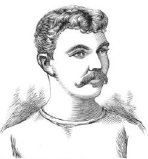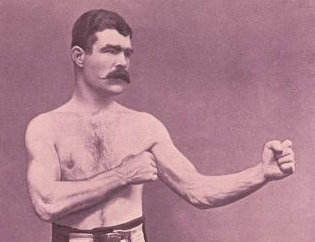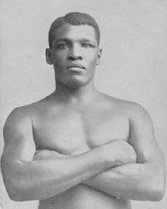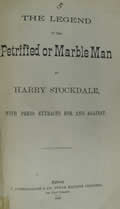
Contact

Home


The Marble Man.
Bathurst Free Press and Mining Journal (NSW)
Date: October 1, 1889
Page Number: 3
The following letter appears in Saturday's Daily Telegraph :
Sir, In report in Tuesday's issue of certain local proceedings in re the bankruptcy of G. F. Sala, the supposed finder of the marble or, more correctly speaking, stalamite man, your correspondent says "the result will be calculated not a little to discourage Dr. M'Carthy and other scientists whose faith in the reality of the supposed curio has been unbounded." Speaking for myself, I can say that, far from being shaken in my opinion , I am more convinced of its absolute correctness ; and I am sure I can answer equally for others, including leading Melbourne geologists, sculptors and other scientific men, a letter from one of whom, viz.. Dr. Halford, professor of histology and physiology and physiological anatomy of the University of Melbourne, I have lately read with much interest. This conclusion of your correspondent is arrived at because of evidence, given to the effect that the figure was carved out at Cow Flat. But, in this statement there is nothing new. We are simply treated in the evidence to a rehash of the original police report, which has long since been everywhere, spoken of as an official blunder, upon which no reasonable conclusion could be based. I have already shown on indisputable, grounds, that it is a wild absurdity to suppose that, even an imitation of this figure could be carved out, with or without a model, in the time stated, at Cow Flat or anywhere else. The individual who now states in evidence that he saw it, made at Cow Flat, says it first, looked "like the figure of a woman." but, when next, he saw it "It looked like a man." His statement, nevertheless, of Sala's effort to 'plant' it in a well may be perfectly reliable, for I have little doubt this stalagmite-fossil was at Cow Flat, but have equally little doubt it was imported there. I had suspicions from the beginning that it was an imported article and they are now more than verified. What, I wonder, will be thought by intelligent people of police evidence and doings in court on reading the following letter from Signor Besomo, an ltalian resident, addressed to me :
"155 Elizabeth-street, Sydney, September 26, 1889. Dr. M'Carthy.
"Sir, Having noticed in the Daily Telegraph that great, efforts are made to prove that the marble man is a work of art, for your information I desire to state what I know about, it. Mr. Sala lodged with my family for several weeks, during which time I did most if not all his correspondence, and by what I could gain from his conversation I have every reason to believe that the marble man was in his brain long before he went to Cow Flat. Those that would have the people of New South Wales to believe that the marble man was sculptured at Cow Flat by Mr. Sala must be great Hats themselves, or that it was found in a marble quarry at Orange. I am pretty well certain of the contrary, for the correspondence I did for him points to an opposite direction ; but I have reason to believe with you that the marble man was a fossil. Some time ago I went to the trouble to turn up my correspondence re three cases marked F.G.S., containing a marble man, woman and child. The correspondence was first addressed to Naples some agent there then to Liverno, then to New York, then to San Francisco, and lastly to Honolulu. They were all shipping agents ; and in every instance the correspondence had reference to the above three cases marked F.G.S., and the contained marble statues which came from Naples. Long before anything was known of the marble man Mr. Sala used to say that the doctors and scientists would disagree about something which he was going to do, and as it turned out to be correct I must say that I feel convinced that the marble man has not been sculptured at Cow Flat.
Yours. &c.. P. BESOMO."
If Mr. Besomo's statement be true (and every word bear the stamp of truth), then I ask what if on such police reports and court, proceedings some more vital issue were depending ? Turning to our fossil ! As it was not chiselled out at Cow Flat nor discovered in New South Wales, it would be interesting to get its history. But it would possibly require the genius of a Rider Haggard to throw light on this part of the subject Mr. Sala evidently knows no more about its original discovery than he did of its value or the process of chiselling it out. It has probably changed hands over and over. For my part, at the onset of this controversy (which is now ended as far as I am concerned), I stated that I cared not one iota whether it, hailed from Caleula, Cow Flat or California. Putting aside all prejudice. I judged the specimen only, subjecting it to the usual scienfific tests, in none of which found it was wanting ; strove by every means in my power for the public verification of those tests, and gave stern facts and adduced abundant, arguments, none of which, has ever been controverted, and which, indeed, from a geological, anatomical, chemical and sculptural point of view were final and unanswerable. May I here repeat that in carrying this controversy through as perhaps few would have ???. I have had no interest to stimulate ??? than the love of science and truth.
Yours &c., Charles W. M'CARTHY
An Amusing Skit.
Clarence and Richmond Examiner (Grafton, NSW)
Date: October 26, 1889
Page Number: 6
"THE Marble Man," by Mr. A. G. Taylor, is an amusing skit purporting to give the "humors of the life's history" of the remarkable object the exact nature of which excited so active a controversy, and so much stimulated the curiosity of the public. It opens with a soliloquy by the "Marble Man," in which he complains in humorous fashion of the expressions, mingled with ridicule and mistrust, which have been cast upon him, from which he pleasantly vindicates himself. He then relates how he came into existence at the early part of this century by the cannibalism of some convicts and a gaol chaplin, the survivor of whom was eaten by Bundarra, a native warrior, who then died from repletion in the cave to which he retired after his meal, and was there converted by petrification into his present fossilised form, the result, as the author expresses it, of "the calcareous union of four bodies, three of which had been rendered boneless, each by the teeth of his destroyer and immediate survivor." After long entombment he is brought to light and life by the labors of a certain Pietro Paoli, and when taken to the capital he naturally fraternises with the public statues, in whom he sees people of his own kind. The narration of his adventures allows of many amusing references to the time and bits of personal satire. A coroner's inquest of an amusing kind is held on the Marble Man, and ultimately as the investigation discloses the existence of a "distinctly developed fossil not yet included in the ranks of Legislative Councillors," he is appointed as a member of that body. The scope of the jen d'esprit allows of the introduction of what the pantomime writers call topical hits, and the fun of the joke is well maintained to the end.
Bonds Very Hard to Break.
Bathurst Free Press and Mining Journal (NSW)
Date: December 30, 1889
Page Number: 2
At the present moment we are rather put out of countenance by the triumphant manner in which the Imperial Federation faddists point to the course of late circumstances as proof "strong as holy writ" that the bonds of union between England and ourselves are being more surely clinched. Searle, Slavin, Peter Jackson, and the marble man are each and all brought forward as incontestable evidence of the existence of these bonds "light as air, but strong as iron," that bind us to the Mother Country. Mr. Parkin is assuming influential audiences that the sense of loyalty throughout Australia is fairly astounding, and that the fondest wish of the colonists is, that federation should take the shape of a Dominion with Alexander of Battenburg as Governor-in- Chief, and generally speaking we are told that a distinct Australian nationality is a far dream of the future. We give in to all this and consent to feel small, only chuckling to ourselves at the thought that after all, the true bonds that unite us to the tight little island have never been touched on by the imperialist faction.



Henry Ernest Searle
Frank "Paddy" Slavin:
"The Sydney Cornstalk."
Peter Jackson

Another Petrified Man.
Barrier Miner (Broken Hill, NSW)
Date: May 9, 1890
Page Number: 3
ORANGE, Friday afternoon.
Mr. G. F. Sala, of marble man renown, has brought to town another marble man, much like the former one, only he is in a crouching position.
Wonderful Discovery of Remains, Human and Animal, in Marble Petrifaction.
Bathurst Free Press and Mining Journal (NSW)
Date: May 22, 1890
Page Number: 3
From 'The Tourist.'
During my visit to Orange I was in formed that another marble man was being exhibited in the town. I visited the place, and there saw the boy Sala, who had charge of the marble man No. 1 when in Sydney. The place of the exhibition was a small room in the principle street in Orange, admission one shilling. I paid, and entered the room, which was lighted with two candles, without even a candlestick one being held in the hand of a doorkeeper, the other placed upon the head of the marble-man. The appearance of this object is extraordinary. It is coated all over with white chalk or lime to a thickness of about a quarter of an inch. You are permitted to dig this off, and then you come to the solid marble. The head is 36in round. The neck 35in ; 22in across the chest to each shoulder ; from the crown of the head to the chin, 17m; while the whole figure is only 3ft 6in in length. The face has certainly the appearance of a better class of aboriginal, with thick lips, broad nostrils, large eyes, slightly receding forehead. The neck is enormous. He must have died from apoplexy. Fancy a 36in collar for a man ! However, there it is. Upon turning him over you can see where the legs have been doubled up under his arms, and the arms placed alongside them ; thus you only see the feet, the toenails of which are visible, and are a different color to the other marble ; so are the nails on the hands. Wether it was ever a human being or not, it is impossible for me to say, nor could I tell whether it had once been worshipped in the pleistocene period as a god. Mr. Sala says anyone can make any test he likes with it, bore holes in it, or adopt any method thought necessary for proving what it is. All he knows is, that his partner and his son took it out of the ground at Caloola marble quarry.
In the room was also a quantity of fossils some of which resembled human hands and feet, and one the foot of a marsupial. Here was also what were apparently animal remains, fossils, that would take a curator of a museum to decipher. "Where did you get these ?" I asked, "All out of the quarry, sir." "How far is the quarry away from here?" "About fifteen miles," or three and a half miles from Mullion Station." "I should like to see it. Will you go with me ?" "With much pleasure, sir." "I will get a buggy and start about 9 o'clock. Will that suit you ?" "Yes, sir." Next morning we started, and reached the quarry about 12.30 ; the latter part of the road being somewhat rough. The horse attended to, now for this quarry so much talked about. The proprietors of the quarry are W. Briden, Edward Sala, and Francis lvey. The latter was residing on the selection in a tent, and showed me over the place. He evidently took no interest in fossils, his object being to get out good marble for market. This I observed by the iconoclastic manner in which he broke them up. He first directed my attention to a huge block of red and white marble which had been squared and faced, and told me all about the working of the same, and the trouble it was to get blocks out with their rude machinery which consists of four sheer legs, and a crab winch. This explained, I wanted to see the mysterious. Well, here is what is called "the whale." I beheld the form of some gigantic species of reptile or fish about 30ft in length. There are the open jaws perfectly distinct, and resemble the whale's without teeth. Then the back with a hump about the back of the head is plainly vissible. The ribs are are also distinct down to the tail or extremity. All it wants is digging out, "and," said Sala, "the Museum can have this or anything else they can discover on the ground." The whale, (?) I should think, being as it is solid marble, would weight 100 tons. "Of course," Sala remarked subsequently to me, "if they don't take him I will cut slabs of marble out of him." "Well, where did the marble man come from ?" was the question. "From the next quarry, sir, about 300 yards west." Look at this, like a horse. There it was some large animal, the ribs showing distinctly, and I got a pick and removed the earth, or clay, for some distance and exposed the hip joints. It would take a day to dig it out. Unfortunately, Mr. Ivey, in order to get the cart into the quarry, broke the head in pieces, throwing the fragments on the bank, where they still remain. This specimen should be secured for our Museum. "I saw enormous, feet of animals that must have had claws like a cat, and legbones and jaw bones of enormous animals the Nototherium or Deprotoden I should think by the similarity to those shown at the Museum. Observing something white in one of the cuttings I stripped the grass downward with pick and shovel, and my efforts were rewarded by an enormous under jaw of one of these brutes, showing the dentition or teeth almost perfect. About the root of the tongue there was a piece of pure blood red marble, while all the other portion was of red and white marble, coated with lime chalk. It weighed about 100cwt. On the solid face of the marble rock there are several impressions as if a family had laid there, each showing the resting cavity for the head. Two places appear as if the ribs of starved individual had caused the indentation and impression when the marble was soft. Between these two is an impression for the head, as if something had laid upon its side. There are also impressions much smaller resembling what children would make ; but again, Ivey, anxious to show his best marble, with a sledge hammer broke a piece off one of these impressions. I implored him not to disturb any more of these places showing remains, until the Museum authorities had inspected them. I picked up subsequently what wonderfully resembles a woman's skull - marble of course two eyes, mouth, and ears being visible, notwithstanding it has been greatly compressed and flattened. Strange to say, through the centre of the skull there is a vein of crystallised quartz, which seem to start from one of the eyes.
Another thing we dug out was what resembles exactly the chest of a woman, showing one full breast with a very large nipple, while the other is almost flat with out a teat. I dug out a marble hand a female's showing finger nails, and got so interested in the discovery, for it is all virgin soil, and each successive spade of earth removed exposed some other fossil, that I could have stayed for a week ; but night was drawing on, and we had to return homeward. The other, or what is known as No. 3 quarry, is of white marble only; some equal to Parian in appearance. Here fossils were visible ; but very little work in the shape of excavation has been done. I brought several specimens of the fossils away, and these can be seen at the Evening News office. I have now no doubt that the first marble man was genuine, and discovered and unearthed at No. 2 quarry.

The Marble Man part 12








